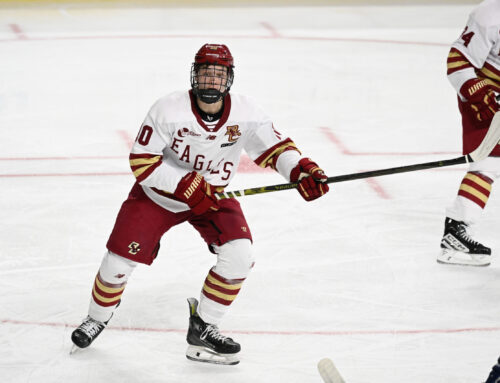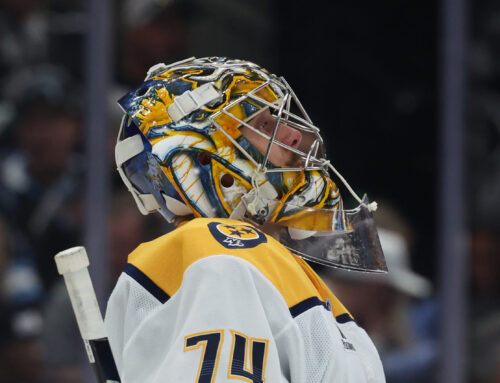With no games on Sunday, I thought we'd see how individual and team performances differed between this season (2023-24) and last season (2022-23). Specifically, we'll focus on the greatest power-play decline/improvement, team offenses, and player shot averages. Let's get into it!
Greatest Power Play Decline: Buffalo Sabres (-6.8%)
Last Season: 23.4% (Rank: 9)
This Season: 16.6% (Rank: 29)
Considering how dangerous they were with the man advantage last season, Buffalo's power play struggles this year are a bit of a mystery. They had the same personnel available, but just couldn't recreate last year's magic.
Dylan Cozens, who saw prominent minutes on the top unit last year, was relegated to the second unit for a lot of this season, with Casey Mittelstadt often taking his place. A down year from Cozens partially contributed to the team's less potent power-play. The 23-year-old forward went from a 68-point breakout season last year to a disappointing 47-point campaign this year. While the team may have been able to withstand regression from Cozens, the simultaneous struggles of team heartbeat Tage Thompson proved insurmountable. After scoring at a 99-point pace last year, Thompson paced for just 65 this season. He was hindered by injuries and couldn't consistently display that game-breaking talent he flaunted last year. If your greatest offensive threat isn't firing on all cylinders, it's going to take some wind out of your power play's sails.
As you can see below, lacklustre power play production contributed to a decline in overall production for core members of the top unit.
| Total Points | This Year | |||
| Last Year | This Year | Total Points | PPPs | |
| Tage Thompson | 94 | 56 | 34 | 16 |
| Jeff Skinner | 82 | 46 | 21 | 12 |
| Alex Tuch | 79 | 59 | 20 | 11 |
| Rasmus Dahlin | 73 | 59 | 32 | 20 |
The Sabres will have new voices guiding the power play next year as head coach Lindy Ruff and assistant coach Seth Appert are set to take over.
Greatest Power Play Improvement: Carolina Hurricanes (+7.1%)
Last Season: 19.8% (Rank: 20)
This Season: 26.9% (Rank: 2)
Although it experienced some turbulence during the playoffs, Carolina's power play was excellent during the regular season. The team converted on 26.9% of its opportunities, a success rate that ranked second to only Tampa Bay.
Just like last season, Sebastian Aho, Andrei Svechnikov and Brent Burns saw major minutes on the top unit. We did see some alterations to the final two spots of that unit though, with Seth Jarvis and Michael Bunting/Jake Guentzel occupying positions that were held by Martin Necas and Stefan Noesen last year. That Necas/Jarvis swap prompted a decline in Necas' production and an uptick in Jarvis'. Such a result may have made Necas more expendable to the club, which would explain why his name has been circling in trade rumours.
Carolina's lethal power play was a major reason that Sebastian Aho recorded a career-best 89 points this season. 32 of those points came with the man advantage, which also represents a career-high total.
Considering Guentzel racked up nine power-play points in his 17 regular season appearances with the Hurricanes, it's tempting to conclude that he was responsible for the team's improved power play. However, Carolina was already near the top of the league with a 26.4% success rate before Guentzel made his debut on March 12th, so it'd be unfair to attribute all of the team's success to him.
Greatest Offensive Improvement: Nashville Predators
Last Season: 2.72 GF/GP (Rank: 28)
This Season: 3.24 GF/GP (Rank: 10)
A healthy Filip Forsberg and a couple of integral free agent signings created a new-look top line that took Nashville's offense to a new level. After being limited to just 50 games last year, Forsberg appeared in all 82 this season, racking up a career-high 48 goals. He was flanked by newcomers Ryan O'Reilly and Gustav Nyquist, who ranked second and third in team scoring, with 26 and 23 goals respectively. This trio should remain intact next year, making Nashville's offense one to watch again. It's worth noting that this was Andrew Brunette's first year coaching the Predators, as John Hynes was behind the bench last season.
Greatest Offensive Decline: Seattle Kraken
Last Season: 3.52 GF/GP (Rank: 4)
This Season: 2.61 GF/GP (Rank: 29)
Last year, Seattle's offense was strong at the top thanks to Jared McCann and Matty Beniers, but it was also deep thanks to contributions throughout the lineup. Unfortunately, McCann and Beniers were riding somewhat lofty shooting percentages and took steps back this year. Their regression, coupled with offseason departures of Daniel Sprong, who potted 21 last year, as well as Ryan Donato, who potted 14 last year, resulted in the team's offense falling off. During the 22-23 campaign, the team had 13 players tally 13 or more goals. This season, they had just six break that mark. It'll be interesting to see if new coach Dan Bylsma can inject some life into the Kraken attack next year.
~
Players that take a lot of shots provide a ton of value in fantasy hockey formats. There's the obvious contribution if your league tracks shots on goal, but shooting more often mean scoring more, so high-volume shooters are likely to help you in the goals category. Given the importance of shots, it's useful to investigate when a player's shot volume has changed from year to year. As we make projections for the season ahead, it's important to understand whether changes are lasting or fleeting. Here are my thoughts on a few players who shot the puck significantly more/less this year than they did last year.
Shooting More
Last Season: 3.3 shots/game
This Season: 4.4 shots/game
Eichel's increased shot rate was in part fuelled by increased offensive opportunity as he went from seeing 18:46 of ice time last year to 20:31 this year. His share or Vegas' power-play time also jumped from 62.5% to 73.5%. I'd expect him to maintain this opportunity next year, allowing him to flirt with four shots per game again.
Last Season: 3.1 shots/game
This Season: 4.2 shots/game
I'd be wary because Forsberg has hovered around three shots per game for most of his career, suggesting this year's increased shot volume may be an anomaly. That being said, this year was his first beside O'Reilly and Nyquist, so it's plausible that the trio's dynamic allows Forsberg to shoot more than he has in years past. It didn't hurt that his average ice time was up a minute and a half relative to last season.
Last Season: 1.7 shots/game
This Season: 2.6 shots/game
Seeing a two-minute jump in ice time and finding chemistry beside two offensively gifted players in Artemi Panarin and Vincent Trocheck was always going to result in more scoring chances. I have a feeling Laf's days of averaging less than two shots per game are over. It may be some time before he cracks New York's top power play, but once that happens, he should routinely average over three shots per game.
Last Season: 1.9 shots/game
This Season: 2.7 shots/game
This was Bouchard's first full season quarterbacking Edmonton's power play. His share of PP time jumped from 46% last year to 77.5% this year. His overall ice time also saw a sizeable increase, from 18:31 to 23:00. Considering how well he performed in his new role, he's sure to see a similar one next year, giving him ample opportunity to flirt with three shots per game again. It's also worth noting that Bouchard posted 2.5 shots per game during the 21-22 campaign, when he was seeing even less offensive opportunity.
Shooting Less
Last Season: 4.2 shots/game
This Season: 3.0 shots/game
Meier's reduced shot volume this year was mainly due to unfavourable deployment. His total ice-time and share of power-play action increased dramatically once Tyler Toffoli was traded in early March. Meier went from 2.78 shots per game pre-Toffoli-trade to 3.55 per game post-Toffoli-trade. A full season of favourable deployment and better health should help Meier hover around four shots per game again.
Last Season: 3.8 shots/game
This Season: 2.8 shots/game
Robertson saw a slightly reduced role this year, but I don't think the magnitude of that change justifies his fall-off in shot volume. His ice time only fell by 30 seconds and his power-play share only dropped 6%.
In his first two seasons, Robertson averaged 2.5 and 3.0 shots per game. That makes last year's 3.8 seem like the outlier, but I wouldn't put too much stock into his early years because he was still finding his footing in the league. I'd say last year's breakout was an accurate reflection of what the 24-year-old is capable of going forward, and he'll be back around that 3.5-4.0 shots per game next year. I also wonder if playing beside an aging Joe Pavelski affected Robertson's output this year. Was Pavelski more of a hindrance than a help down the stretch? We should get an answer to that question early next year as Pavelski is now set to retire. It's worth noting that Pavelski led the team in power-play shots this year, posting 58 to Robertson's 53. Last year, Robertson led the team with 99 while Pavelski had 63.
Last Season: 3.1 shots/game
This Season: 2.3 shots/game
Burns will be turning 40 next season, which makes age-related decline more of a concern. We already saw signs of it this year as Burns' point total dropped from 61 to 43 and his average ice time fell to 21:30. At this stage of his career, he isn't as effective and won't get the deployment necessary to be the high-volume shooter he was in his prime.
~
Thanks for reading! If you ever have any fantasy hockey questions, follow me on Twitter @BrennanDeSouza and shoot me a message!





 FLA
FLA CHI
CHI NYR
NYR PIT
PIT L.A
L.A COL
COL UTA
UTA BOS
BOS BUF
BUF SEA
SEA NYI
NYI VAN
VAN TOR
TOR CBJ
CBJ DET
DET CGY
CGY
